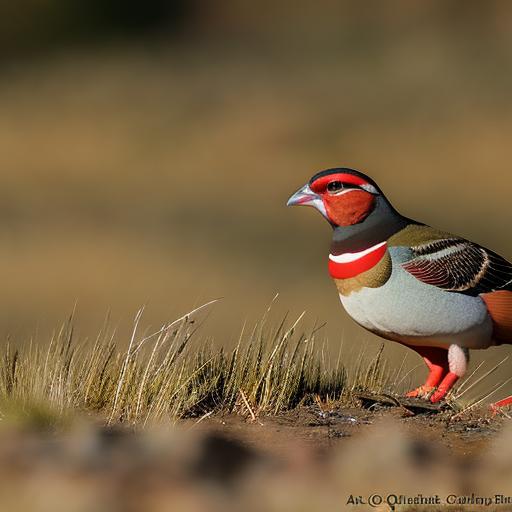Your cart is currently empty!

Why Chukar Bird Hunting is the Ultimate Challenge for True Hunters!

Table of Contents
Introduction
Ah, chukar bird hunting. If you’ve never tried it, you’re in for a treat—and quite the challenge. As someone who’s spent a good chunk of their life chasing after small game, I can tell you that hunting chukar birds is a different beast altogether. It’s not just about the hunt; it’s about the adventure, the unpredictability, and the sheer thrill of the chase.
The first time I set my sights on a chukar bird, I was cocky. I thought, “How hard could it be?” I’d hunted quail, pheasant, and even the elusive woodcock. But nothing, and I mean nothing, prepared me for the cunning and agility of the chukar bird. These birds are not just swift; they’re smart. They know their terrain, and they use it to their advantage. One moment you think you’ve got them cornered, and the next, they’ve vanished into thin air—or so it seems.
But it’s not just the birds themselves that make this hunt so exhilarating. It’s the landscapes they call home. Rugged, steep, and often unforgiving, the terrains where chukar birds thrive are as much a part of the challenge as the birds themselves. It’s a test of your endurance, your wit, and your passion for the sport.
So, if you’re looking for a hunting experience that’s a cut above the rest, you’re in the right place. Whether you’re a seasoned hunter or just starting out, this guide is for you. Let’s dive into the world of chukar bird hunting and discover why it’s the ultimate challenge for true hunters.
The Elusive Nature of the Chukar Bird
Ah, the chukar bird. If you’ve ever set your sights on one, you’ll know they’re not your average game bird. Let’s dive into what makes these birds such a unique challenge for hunters like us.
Habitat and Behavior: A Game of Hide and Seek
Chukars thrive in some of the most rugged terrains you can imagine. We’re talking steep, rocky slopes and arid mountainous regions. These birds have a knack for picking habitats that offer them the best vantage points, allowing them to spot predators (or hunters like us) from a distance. Their preferred terrains aren’t just their homes; they’re their defense mechanisms. The uneven grounds, the shrubs, and the rocks all play into the chukar’s strategy of staying hidden and safe.

Masters of Camouflage and Swift Flight
But it’s not just the terrain that’s on their side. Chukars have this uncanny ability to blend seamlessly into their surroundings. Their plumage, a mix of gray, black, and white, often mirrors the rocky landscapes they inhabit. Many times, you won’t even realize a chukar is nearby until it takes flight, startling you with its sudden burst of speed. And speaking of flight, these birds are swift. They have a rapid, straight flight pattern, often flying low before ascending quickly, making them a challenging target even for the most seasoned hunters.
Chasing Shadows: My Personal Encounters
I remember one particular hunt, a crisp morning in the high desert. I’d been tracking a covey of chukars for hours, guided only by their distinctive calls echoing off the canyon walls. Just when I thought I had them cornered, they’d vanish, leaving me scratching my head and second-guessing my decades of hunting experience.
Late in the afternoon, as the sun cast long shadows over the rocky terrain, I spotted a lone chukar perched on a boulder. I approached stealthily, every step calculated. But just as I was about to take my shot, the bird took flight, its swift wings cutting through the air, leaving me in awe and, I’ll admit, a bit frustrated.
That day, I didn’t bag a chukar, but I gained a profound respect for these elusive birds. It was a reminder that in hunting, as in life, it’s not just about the catch. It’s about the chase, the learning, and the stories we gather along the way.
So, fellow hunters, as you venture into the world of chukar bird hunting, embrace the challenge. Respect the bird, learn its ways, and remember: every hunt, successful or not, adds a chapter to your hunting story.
The Demanding Terrain of Chukar Habitats
When it comes to chukar bird hunting, the terrain is as much your adversary as the bird itself. It’s a game of endurance, wit, and strategy. Let’s delve into the landscapes these birds call home and how you, as a hunter, can best prepare for the challenge.
Rugged and Steep: Nature’s Ultimate Playground
Chukar birds have a penchant for the dramatic when it comes to choosing their habitats. They favor the steep, rocky slopes of mountainous regions, often at elevations that would leave many of us gasping for breath. These terrains are not just challenging; they’re unpredictable. Loose rocks, sudden drops, and the occasional hidden ravine are all par for the course. It’s no wonder these birds feel at home here; the terrain offers them both protection and a vantage point to spot potential threats.
Physical Demands: Preparing for the Hunt
Given the challenging landscapes, it’s essential to be physically prepared. Chukar hunting isn’t a leisurely stroll in the woods; it’s a full-body workout. Expect long hikes, steep climbs, and the occasional scramble over rocky outcrops. Cardiovascular fitness is crucial. Before embarking on a chukar hunt, I always recommend a few weeks of cardio training, be it jogging, cycling, or even brisk walking. Strengthening exercises, especially for the legs and core, can also be beneficial. And don’t forget to break in those hunting boots; blisters are the last thing you want when chasing chukars.

Navigating the Terrain: Tips from the Trenches
Over the years, I’ve picked up a few tricks that have served me well in chukar country:
- Stay Light: Pack only the essentials. A lightweight pack allows for better mobility and less fatigue.
- Use Trekking Poles: They provide stability, especially when descending steep slopes.
- Study the Landscape: Before diving in, take a moment to survey the terrain. Identify potential routes and lookout points.
- Stay Hydrated: The arid mountain air can be dehydrating. Carry ample water and take regular sips.
- Mind Your Footing: Always test a rock’s stability before putting your full weight on it. A twisted ankle in chukar territory is no joke.
Remember, the terrain is both your challenge and your ally. While it offers the chukar bird protection, it also provides you with opportunities. Elevated vantage points can give you a bird’s-eye view (pun intended) of the landscape, helping you spot chukar movements and plan your approach.
In the end, respect the terrain, prepare adequately, and embrace the adventure. After all, it’s the rugged landscapes and the challenges they present that make chukar bird hunting the thrilling experience it is.
The Skills and Equipment Needed for Success
Chukar bird hunting is not just about the chase; it’s a blend of skill, strategy, and having the right gear. As with any hunting expedition, being well-prepared can make the difference between a memorable hunt and a day of frustration. Let’s dive into the essential skills and equipment you’ll need to ensure success on your chukar hunting adventure.
Patience, Precision, and Strategy: The Hunter’s Trinity
- Patience: Chukar birds are elusive, and they won’t always play into your hands. There will be days when you’ll trek for hours without a single sighting. It’s essential to remain patient, stay alert, and trust the process. Remember, it’s the challenge that makes the catch worthwhile.
- Precision: When the moment finally arrives, and a chukar takes flight, you’ll need to act swiftly and accurately. Your shot needs to be precise, especially given the bird’s rapid flight pattern. Regular practice at a shooting range can be invaluable.
- Strategy: Understanding the bird’s behavior, its preferred habitats, and its daily routines can give you a strategic advantage. Do they frequent a particular watering hole? Are there specific times of day when they’re most active? Gathering such intel and planning your hunt around it can significantly increase your chances of success.
Essential Equipment: Gear Up for the Hunt
- Firearms: A lightweight, over-under or side-by-side shotgun is ideal for chukar hunting. A 20-gauge with improved cylinder and modified chokes can be particularly effective, offering a good balance of range and firepower.
- Footwear: Given the rugged terrains, a sturdy pair of hunting boots is crucial. Look for boots with good ankle support, aggressive tread, and a comfortable fit.
- Camouflage: While chukars have sharp eyes, they’re not particularly adept at picking out camouflaged hunters. Opt for gear that blends with the rocky, arid landscapes typical of chukar habitats.
Personal Recommendations: Gear That’s Passed the Test
Over the years, I’ve tried a plethora of gear, but a few items have consistently proven their worth:
- Shotgun: The Beretta Silver Pigeon I is a reliable choice for chukar hunting. It’s lightweight, durable, and offers excellent accuracy.
- Boots: The Danner Pronghorn series has served me well. They’re rugged, comfortable, and provide excellent traction on rocky slopes.
- Camouflage: Sitka’s Ascent series offers a good blend of durability and concealment, perfect for the terrains chukars call home.

Related Questions
How does chukar bird hunting compare to hunting other small game?
Ah, chukar hunting is a league of its own! Unlike other small game, chukars thrive in rugged terrains, making the hunt both physically demanding and mentally challenging. Their elusive nature and swift flight patterns require a unique blend of patience and precision. It’s less of a casual pursuit and more of an adventurous expedition.
What’s the best time of year for chukar bird hunting?
The prime time for chukar hunting is during the fall months. Temperatures are cooler, making those steep climbs a tad more bearable. Plus, the birds are more active as they prepare for winter. Late September to November usually offers the best opportunities, but always check local regulations for specific hunting seasons.
Are there any specific calls or lures that work best for attracting chukar birds?
Indeed, there are chukar calls available that mimic their unique chirp, helping attract or locate these birds. However, it’s essential to use them sparingly; overcalling can make the birds wary. As for lures, there aren’t any specific ones for chukars. It’s more about understanding their behavior, habitat, and using strategic techniques to approach them.
Summary
In the world of small game hunting, chukar bird hunting stands out as a pinnacle experience. It’s not just about bagging a bird; it’s about the journey, the strategy, and the stories you’ll have to tell. From the elusive nature of the chukar bird to the rugged terrains they inhabit, every aspect of this hunt demands your utmost attention and respect.
But here’s the thing: while the challenge is real, so is the reward. There’s an unmatched sense of satisfaction in outsmarting a chukar bird, in navigating treacherous terrains, and in honing your skills to perfection. And trust me, once you’ve tasted the thrill of a chukar bird hunt, no other hunt will quite compare.
For hunters of all skill levels, I encourage you to embrace the challenge. Equip yourself with knowledge, patience, and the right gear. And remember, it’s not just about the catch; it’s about the memories you make, the lessons you learn, and the bonds you forge along the way. Here’s to the next adventure, and may your chukar bird hunting experiences be filled with excitement, success, and stories worth retelling. Cheers!

Herb has been a longtime lover of the outdoors. Whether it be hunting, camping, fishing or just getting outside to reset. Proud father and animal lover. Bourbon anyone?

by
Tags:
Comments
6 responses to “Why Chukar Bird Hunting is the Ultimate Challenge for True Hunters!”
-
[…] the air crisp, and the grouse? They’re often out and about, foraging and starting their day. Hunting during these early hours offers the advantage of catching these birds off-guard, especially before the forest fully awakens. However, the flip side is the challenge of […]
-
[…] Now, onto the pheasant. These birds are a bit larger, often weighing between 2 to 3 pounds for the males, or “roosters” as we often call them. Their coloration is a dazzling display of nature’s artistry. Roosters boast a mix of bright colors – shimmering greens, golds, and reds, with a distinctive white ring around their neck. Their tail feathers are long and pointed, often with a mix of rusty browns. The hens, on the other hand, are more muted in color, blending in with their surroundings with brown and tan patterns. But don’t let their subdued colors fool you; these birds are just as challenging and rewarding to hunt. […]
-
[…] target for hunters. To learn more about this exciting sport, check out this informative article on chukar bird hunting. Discover the best techniques, gear, and strategies to enhance your hunting experience and take on […]
-
[…] If you’re an avid hunter looking for new adventures, you might be interested in reading about elk hunting in Routt National Forest. But if you’re also curious about other types of hunting, such as raccoon hunting at night without dogs or rabbit hunting with a shotgun, you’ll find plenty of informative articles on the Old Oak Syndicate website. One article that caught my attention is “Chukar Bird Hunting: Tips and Techniques for a Successful Hunt.” Whether you’re a seasoned hunter or just starting out, this article provides valuable insights on how to hunt these challenging birds. Check it out here! […]
-
Wow, amazing blog layout! How lengthy have you ever been running a blog for?
you made blogging glance easy. The overall
look of your web site is magnificent, as well as the content material!You can see similar: najlepszy sklep
and here najlepszy sklep -
[…] If you’re interested in Navajo Nation elk hunts, you may also enjoy reading about Chukar bird hunting. Chukar hunting is a popular sport that requires skill and strategy. To learn more about this exciting activity, check out this informative article on the Old Oak Syndicate website: Chukar Bird Hunting. […]

Categories
- Big Game Hunting (301)
- Deer (202)
- Reviews (3)
- Shooting (16)
- Slingshot (1)
- Small Game Hunting (42)
- Upland Hunting (126)
- Waterfowl Hunting (3)





Leave a Reply